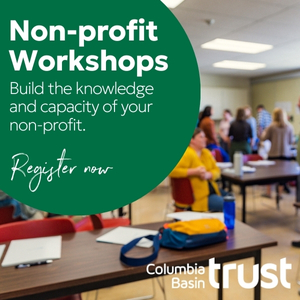
You can hear them well over a kilometre in the distance, their baritone horns serenading the wetlands. The croak of the populated male American bullfrog signals the alarming density of frogs migrating to the Yaqan Nuʔkiy (Lower Kootenay Band) lands and along the Lower Kootenay River, south of Creston.
In an effort to manage the invasive bullfrogs’ effect on local endangered northern leopard frogs and other at-risk species, the Ktunaxa Nation Council (KNC) partnered with the Province of BC, Columbia Basin Trust, Central Kootenay Invasive Species Society (CKISS) and Yaqan Nuʔkiy. The team conducted a successful three-year project, surveying, testing, and implementing strategies to lure, trap, and mitigate bullfrogs across 684 hectares of wetlands.

“Our work made a huge impact on abating the bullfrogs’ expansion into the Canadian wetlands; it would have been disastrous for the local species if we hadn’t stepped in,” explains KNC’s Kerri Garner. Managing the bullfrog population has been an ongoing effort, but this three-year project was supported by the Aboriginal Fund for Species at Risk (AFSAR) and the Trust, which is supporting and strengthening ecosystem health in the Basin. Aside from protecting species like the northern leopard frog, another key takeaway was the relationship building. Everybody on the project worked really well together, growing and learning, and building mutual respect.
“We had an initial vision that quickly shifted,” adds Garner. “Dedication from all partners was critical, as was keeping an open mind to different approaches on how to accomplish the task at hand. The Trust provided flexible funding that allowed us to make the project a complete success.”
Native to Eastern North America, the American bullfrog is the largest frog species and has a voracious carnivorous appetite, eating everything from crayfish, water beetles, snails, dragonfly larvae, small fish, and occasionally small birds, rodents and other amphibians. In addition, they reproduce in larger quantities than any other frog species — up to 20,000 eggs per breeding cycle.

Nelson’s Terry Anderson, an Environmental Technologist and former Habitat Officer for the Province of BC, is fascinated by the pests he’s come to respect over his career. He spends his time leaping after frogs, among other endeavours, under his consultant company Weeds, Toads, and Fish.
“We couldn’t wait to see what would happen,” says Anderson. “If we let the bullfrogs be, they’d take over the Yaqan Nuʔkiy lands, then they’d get into Duck Lake and further into Kootenay Lake — they’d just continue to expand their range. They’re all over the Lower Mainland and lower Vancouver Island, and those areas don’t stand a chance of getting rid of them. But we do, so we’ve been working hard at it.”
Anderson was hired along with subcontractor Colton Luke, a knowledgeable citizen who brought Ktunaxa insight and navigational skills to round out the team’s approach. Together, they worked tirelessly from June 2018 to January 2021, eradicating bullfrogs in the East Kootenay to protect the last remnant population of the northern leopard frog. This region lacks bullfrog predators like cranes to naturally balance the ecosystem, which is why human intervention is necessary.
“Colton was an excellent resource, specifically for his expert knowledge of the land,” says Anderson. “He kept me from getting lost multiple times. When you’re going in and out of all these nooks and crannies and the landscape changes every time the water drops, it’s easy to get turned around.”
The pair tracked the nocturnal amphibians at night, battling the elements. Combatting horrendous bugs, heat domes and lush, wet terrain, they travelled in kayaks, often jumping out to drag them through five-foot tall grass and even taller bullrushes. Visibility was also an issue, as the Yaqan Nuʔkiy wetlands are the lowest point in the valley; when the cool air sinks off the mountains, it hits the warm water and forms a thin layer of mist right at water level.

Through all of these challenges, they were able to capture bullfrogs with netting or by hand, or dispatch them with non-lead pellet rifles or with an anode and cathode wand that delivers a concentrated shock — the most humane method, according to provincial standards. Working together to protect native species and the local environment fostered trust and respect on the entire project team. The extended team included up to five KNC staff, three Yaqan Nuʔkiy staff and members, and about six Province of BC staff and contractors.
Over the course of the project, the number of bullfrog adults, juveniles, metamorphs, tadpoles and egg masses gradually declined, proving their efforts are working. In 2018, early project results documented 454 bullfrogs captured and removed, with numbers rising to 1,464 by 2019. In 2020, numbers decreased to 171 and a mere 52 bullfrogs were captured and removed in 2021.
Numbers aside, knowledge-sharing and skill-building were core values of the project.
“Colton and I have worked together side-by-side through countless nights for five seasons,” says Anderson. “Through those nights, Colton shared his culture with me and helped me begin my journey of reconciliation; for that I am grateful.”
Outreach to the Yaqan Nuʔkiy community increased awareness of invasive bullfrogs and the local species they threaten, including the western toad and western painted turtle. The Ktunaxa knowledge of these species and the wetlands has been compiled for sharing as educational materials.
“We’ve been working closely with the US to stay the course and further develop strategic eradication plans, as the bullfrog will continue to travel north through the waterways,” adds Anderson. “The catch continues — just when you think you know all there is to know about them and where to find them, they move.”
























